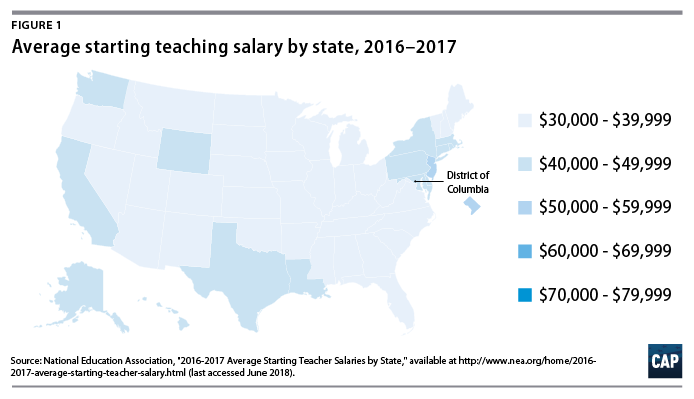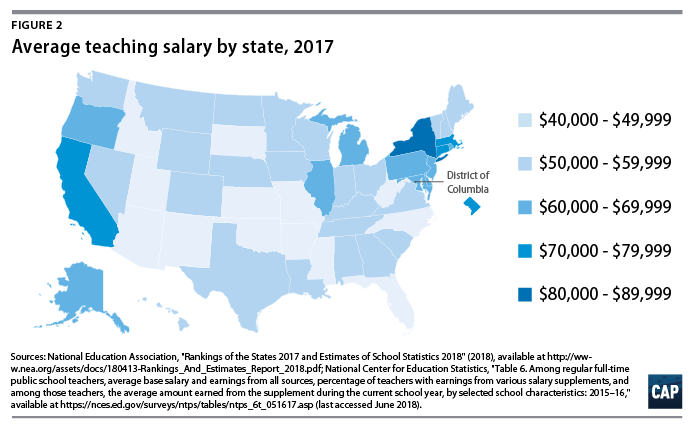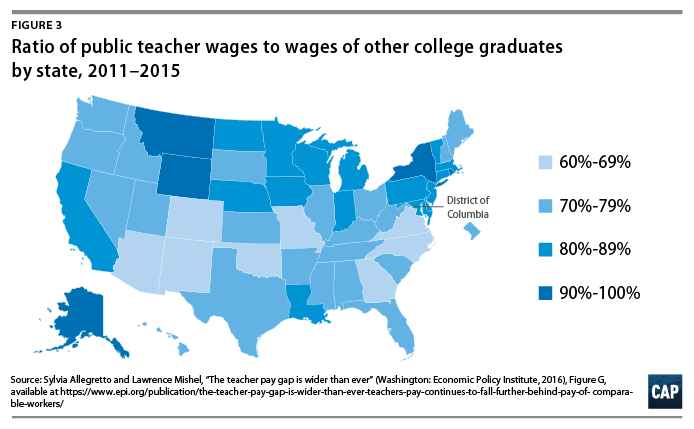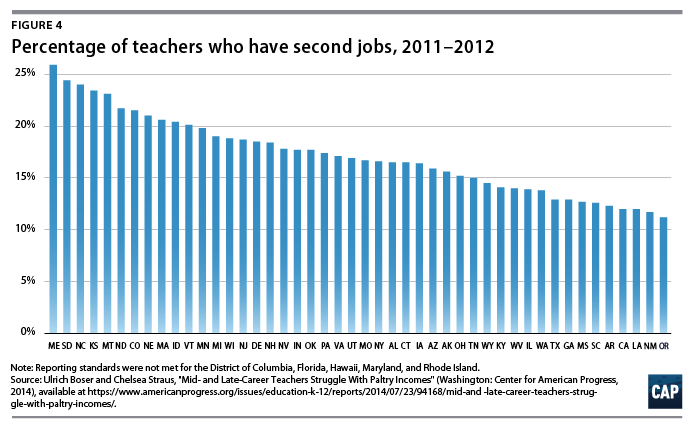In the midst of teacher walkouts and protests in six states,1 Americans across the country overwhelmingly support paying teachers as the professionals they are. According to a recent New York Times poll, nearly three-fourths of U.S. adults believe that teacher pay is too low, and two-thirds support increasing taxes to raise the salaries of public school teachers.2 In addition, an unprecedented number of teachers—who have been fighting for increased education funding, higher teacher pay, and fully funded pensions—are now running for public office.3
Yet there is still debate surrounding whether all teachers need a raise, or if it is enough to make changes for a select group of teachers through differentiated or merit-based pay. While differentiated and merit-based pay can help alleviate some specific teacher shortages, such as those in subjects or schools that are high-needs,4 they are not a substitute for higher base pay. As professionals, teachers are underpaid—and they deserve a raise.
Teachers are underpaid across the country
- The average starting salary for a regular full-time teacher is only $38,617,5 and the average teacher salary is $59,660,6 though both rates vary drastically by state.


- The annual pay for teachers fell sharply from 1995 to 2015 in relation to the annual pay of similar workers.7 According to the Economic Policy Institute, public school teachers are paid less than other comparable workers in every state, and they earn 11 percent less on average, when accounting for nonwage benefits.8 This calculation is based on comparable weekly wages.

- U.S. teacher pay also fares poorly internationally. American teachers work longer hours than teachers in most other Organisation for Economic Co-operation and Development (OECD) countries9 but are paid less relative to other similarly educated workers in most OECD countries.10
- Nearly all U.S. states do not have fully funded pensions for public employees, failing to provide teachers with a secure retirement. According to The Pew Charitable Trusts, state pension funds created a $1.4 trillion deficit in 2016, and only four states have at least 90 percent of pensions funded.11
Teachers are working second jobs, and many are eligible for means-tested programs
- As of the 2015-16 school year, 18 percent of U.S. teachers worked second jobs outside the school system.12 Teachers are about 30 percent more likely than nonteachers to work a second job, and in some states, one-quarter of teachers work second jobs.13

- In many states, teachers earn so little that they qualify for public benefits. Among mid-career teachers—or teachers with 10 years of teaching experience—those who are breadwinners for families of four or more people are eligible for benefit programs, such as the Children’s Health Insurance Program or the National School Lunch Program, in most states.14 Because of their low salaries, in 2014, mid-career teachers qualified for up to seven benefit programs in Arizona, Colorado, Maine, Minnesota, Montana, North Carolina, North Dakota, and South Dakota.15
Low teacher pay contributes to shortages and a disinterest in the teaching profession
- A 2018 National Center for Education Statistics survey found that less than half of all public school teachers were satisfied with their pay; 45 percent of teachers who reported dissatisfaction said they would “leave teaching as soon as possible” if they could find a better-paying job.16
- The percentage of teachers leaving the teaching profession has also increased in the past 25 years.17 Teacher turnover is now twice as high in the United States as in many other countries, including high-performing nations such as Finland and Singapore.18
- Teacher turnover is exacerbated in states with low pay. Teacher attrition is highest in Arizona, New Mexico, and Louisiana, where the average teacher salary is $50,000 or less.19
- Fewer young people are showing interest in the teaching profession. Despite a slight uptick in the 2015-16 school year, enrollment in teacher preparation programs is still substantially less than in the 2008-09 school year and shows an overall declining trend.20 Forty-five states have experienced declines in teacher preparation program enrollments.21
Click here for an appendix containing state-by-state numbers.
Sarah Shapiro is a research assistant for K-12 Education at the Center for American Progress. Lisette Partelow is the director of K-12 Strategic Initiatives at the Center. Catherine Brown is the vice president of Education Policy at the Center.